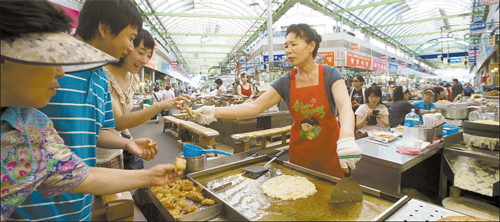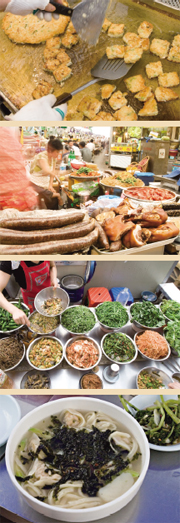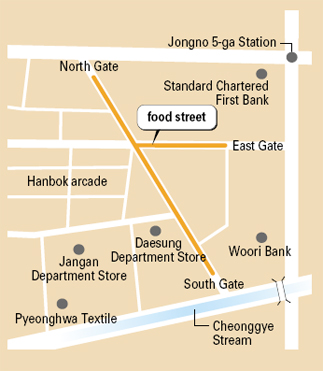Market is a feast for the senses

A vendor at the Gwangjang market near the Cheonggye Stream in central Seoul. By Kwon Hyuk-jae
Seoul has its own open space markets that lures tourists and residents alike ― the Gwangjang Market near the Cheonggye Stream in the Jung District.
The market was established in 1905 as the first official trading market in Korea and until the 1960s, it was known as Dongdaemun Market. But as more vendors arrived, Dongdaemun and Gwangjang became two independent markets.
In its early years, Gwangjang market sold almost everything required for a daily life, but with the emergence of large supermarkets and department stores, it specialized in fabrics and hanbok or traditional Korean costume.
After the Cheonggye Stream was restored in 2002 the market developed a “meokja golmok” (food alley).
The markets restaurants offer a variety of traditional food at a reasonable prices including Korean-style pancakes and homemade dumpling soup. The alley is divided into four squares. The north quadrant sells bindaetteok and jeons (Korean style pancakes), and the east sells jokbal (pork hock) and sundae (Korean-style sausage). The market’s south quadrant sells seafood dishes including hoe (raw fish) and kalguksu (handmade knife-cut noodles), kongguksu (noodles in soybean soup), naengmyeon (cold noodles), dumpling soup, boiled barley and bibimbap (steamed rice with assorted vegetables).

From the top: Bindaetteok; sundae; bibimbap ingredients and sonmanduguk. By Kwon Hyuk-jae
The market alley greets visitors with the tasty smell of fried bindaetteok. Compared to other restaurants outside the market, the pancakes here are bigger. As the big pancakes are made fresh-to-order, they are delicious.
The vendor grinds mung beans and then puts Chinese bean sprouts and water into the dough, then fries the mixture.
The crust is crunchy but the inside is soft and tender. A large size bindaetteok will feed two people and costs 4,000 won ($4.40).
2. Sundae and Jokbal
Sundae is made by stuffing a mixture of bean curd, green bean sprouts, glutinous rice and Chinese noodles into a pig intestine. One bite of the sausage with a sip of soju or watery radish kimchi at the end of the day will relieve all of life’s stress. One sausage costs around 2,000 won.
3. Bibimbap
At Gwangjang Market, bibimbap is served with anchovies and 10 different vegetables ― bracken, stonecrop, Korean leek, radish, lettuce, chicory, cucumber, young radish kimchi, cabbage kimchi and green red pepper. If you feel the taste is bland, add more flavor with doenjang (soybean paste), gochujang (hot pepper paste), seaweed powder or sesame oil. Bibimbap costs 3,000 won.
4. Sonmanduguk
Namdaemun Market is famous for its handmade knife-cut noodles whereas Gwangjang Market is famous for its dumpling soup.
The stuffing includes pork, tofu, bean sprouts, kimchi, onions and leek. The gravy is made with anchovies. Ten dumplings are served in a bowl for 3,500 won.

The open space market also has different kinds of pan-fried foods, including pancakes made with red pepper, green pumpkin, eggplant, potato, fish, leek and kimchi. A dish costs 5,000 won.
You can also taste the Korean flour cake that is made of black red-bean or glutinous rice, priced at 1,000 won. Sweet red-bean soup with rice dumplings and pumpkin soup each cost 4,000 won. Handmade noodle soup and naengmyeon cost 3,500 won.
By Yoo Ji-sang JoongAng Ilbo [estyle@joongang.co.kr]










with the Korea JoongAng Daily
To write comments, please log in to one of the accounts.
Standards Board Policy (0/250자)